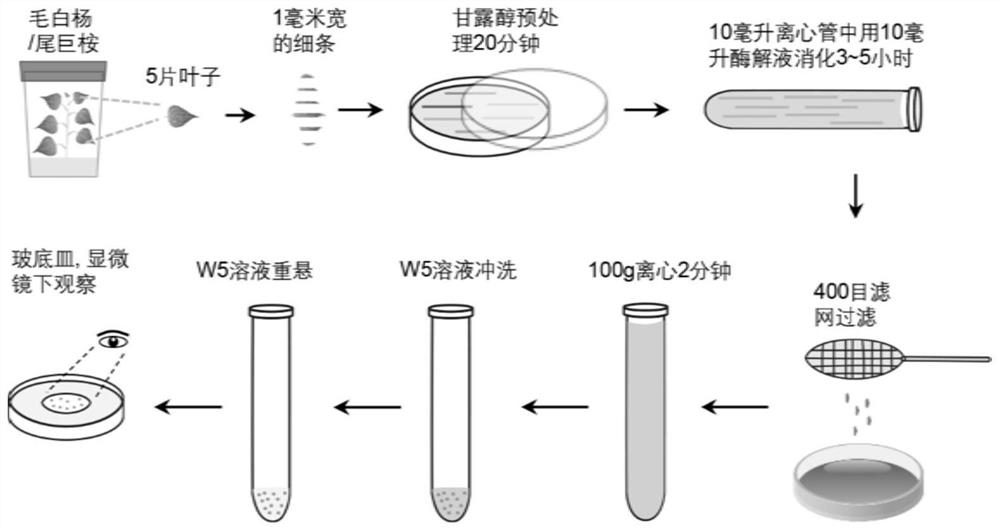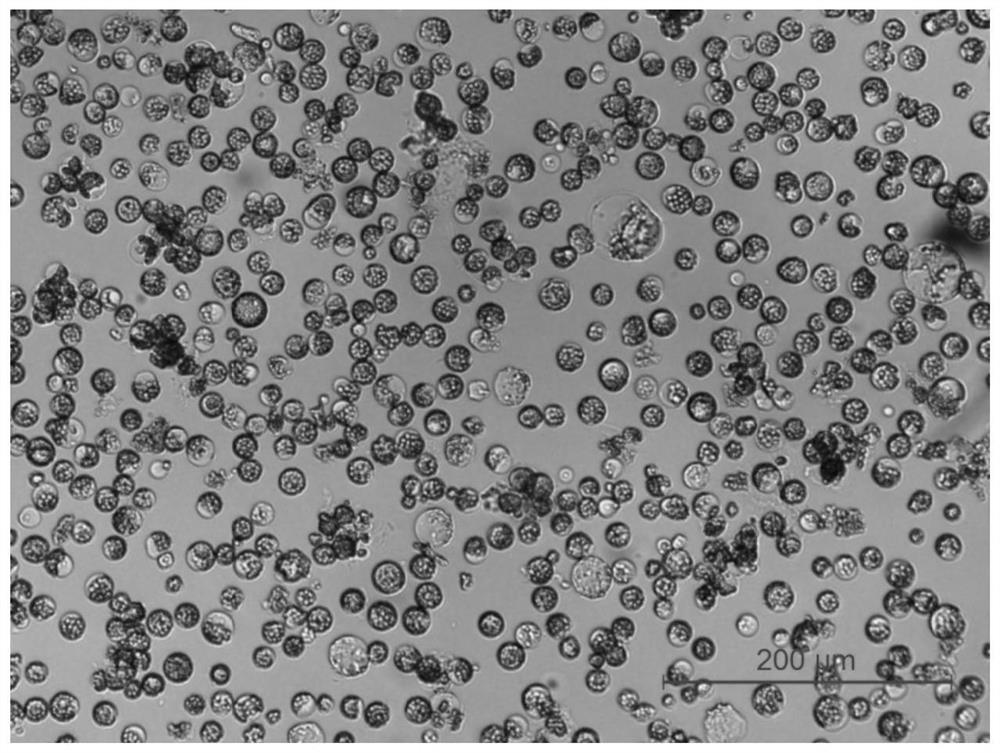Enzymolysis method for rapidly removing cell walls of Populus alba L or Eucalyptus robusta Smith, and application
A cell wall and enzymatic hydrolysis technology, applied in the field of plant genetic engineering, can solve the problem of no report
- Summary
- Abstract
- Description
- Claims
- Application Information
AI Technical Summary
Problems solved by technology
Method used
Image
Examples
Embodiment 1
[0037] Embodiment one: the cultivation of poplar, eucalyptus tissue culture seedling aseptic seedling
[0038] The Populus tomentosa tissue culture seedlings are asexually propagated through the following medium respectively:
[0039] The medium formula used is as follows:
[0040] Callus induction medium: MS+KT 0.5mg / L+0.1mg / L 2,4-D+6.5g / L agar
[0041] Differentiation budding medium: MS+TDZ 0.05mg / L+6-BA 0.5mg / L+6.5g / L agar
[0042] Shoot elongation medium: MS+6-BA0.5mg / L+6.5g / L agar
[0043] Rooting medium: 1 / 2MS+NAA0.5mg / L+6g / L agar
[0044] (1) Exocarp disinfection: first the stem section of the Populus tomentosa plant grown in the wild is cut off, gently scrubbed with a hairbrush, rinsed with running water for 12 hours, dried, and the branch is built into a 3cm long stem section, which is then cleaned in ultra-clean work Soak the table with 75% alcohol for 30 seconds, use sterile water 3 times for 1 minute each time, then disinfect with 2% sodium hypochlorite (NaClO)...
Embodiment 2
[0054] Embodiment two: plasmolysis pretreatment
[0055] (8) Configure 0.8M mannitol solution: prepare a disposable petri dish with a diameter of 9cm, weigh 2.912g mannitol and dissolve it in 20ml ddH 2 O, fully dissolve mannitol and mix well.
[0056] (9) Cut the blades of poplar and eucalyptus into thin strips with a width of about 1 mm with scissors or blades, soak in the mannitol solution prepared in the previous step, and ensure that the blade thin strips are all immersed in the solution.
[0057] (10) Stand at room temperature for 20 minutes.
Embodiment 3
[0058] Example 3: Enzymatic hydrolysis to remove cell walls
[0059] Use a 10ml centrifuge tube to configure 10ml of the enzymatic hydrolysis solution with the following formula:
[0060] 0.15g Cellulase R-10
[0061] 0.04g isolated enzyme R-10
[0062] 0.05g pectinase Y-23
[0063] 1.092g mannitol
[0064] 1ml 200mM KCl
[0065] 1ml 200mM MES
[0066] Add 5ml of ddH 2 O, incubate at 55°C for 10min, after cooling to room temperature, add
[0067] 100 μl 1M CaCl 2
[0068] 66.67 μl 7.5 mM β-mercaptoethanol
[0069] 1ml 1%BSA
[0070] Dilute to 10ml for use.
[0071] (11) Take out the thin strips of poplar and eucalyptus leaves treated with mannitol, drain them, put them into the enzymatic solution (try not to bring out the mannitol solution), and soak them loosely and evenly in a 10ml centrifuge tube containing 10ml of enzymatic solution middle.
[0072] (12) Under dark conditions, place on a horizontal shaker at 23° C., 10 rpm, and perform enzymatic hydrolysis for...
PUM
 Login to View More
Login to View More Abstract
Description
Claims
Application Information
 Login to View More
Login to View More - R&D
- Intellectual Property
- Life Sciences
- Materials
- Tech Scout
- Unparalleled Data Quality
- Higher Quality Content
- 60% Fewer Hallucinations
Browse by: Latest US Patents, China's latest patents, Technical Efficacy Thesaurus, Application Domain, Technology Topic, Popular Technical Reports.
© 2025 PatSnap. All rights reserved.Legal|Privacy policy|Modern Slavery Act Transparency Statement|Sitemap|About US| Contact US: help@patsnap.com



